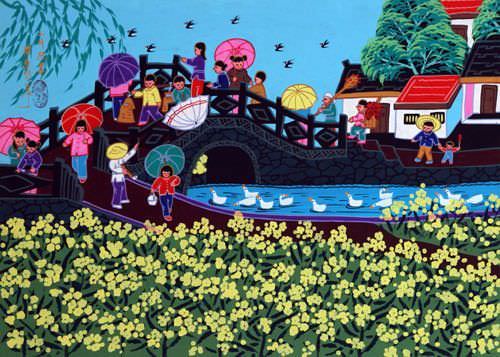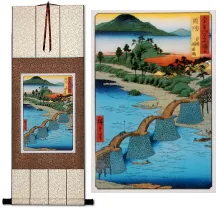



March Market
The Chinese title literally means "Third Moon Get-Together". But the real meaning is "March Market" or "Market-time in March". The "three moons" or "third moon" part is the way that the third month of the year is described in Chinese. The first moon is "January" (though in the traditional Chinese lunar calendar, the first moon of the year is usually in the Gregorian February).
The people in this painting are on their way to the market.
While this painting just depicts people on the way to the market (but not the market itself), I will explain where they are going:
Such "market days" (it's not so much a place, as much as a time, or a happening) are often held every 7 or every 10 days in southern Chinese village or tribal communities. There are often 5 or more villages that participate, and gather at the largest village for the market day.
There is more trading that buying and selling at the market. Example: Two kilograms of freshly-slaughtered pig can get you enough vegetables to tide you over until the next market day. Clothing and sundries are also traded, and most items are hand-crafted, or naturally-grown at these markets.
About the artist...
This painting is by a woman named 

 (Pan Xiao Ling).
(Pan Xiao Ling).
She is from an area known as "Huxian" in the Shaanxi Province of China. Born in 1958, she began painting in 1974.
Her paintings were the first Chinese folk art ever accepted for a series of postcards officially issued by the state-run "China Post" (Chinese Postal Service).
Exhibitions of her work have been seen in America, Japan, and Singapore.
Pan Xiao-Ling's work is a combination of folk and modern art. Her inspiration comes from growing up in a small farming village in the middle of China. This influence really shows in her paintings which usually depict the simple village life in the countryside of China.
About the Painting itself...
The artist used "shui fen" (paint powder and water - similar to gouache), on thick paper to create this painting.
If you get a piece of mat board cut for you, this Chinese painting will fit nicely in a standard 18" x 24" frame. If you want really wide matting, you could even use a 22" x 28" standard picture frame. You should probably get the matting cut professionally, but you can probably handle the rest yourself. Please see our step by step guide to framing Asian art if you want some tips.
About Chinese Folk Art and its History...
This style of folk art was born in the 1950's just after the Revolution (when Chairman Mao took power). The art developed independently in Huxian (Hu County) in the Shaanxi Province for many years (the same Province where you will find the Terracotta Soldiers).
Things changed drastically when the Cultural Revolution came to pass in China. Within a few years, art was only acceptable if it portrayed some form of socialist propaganda, or showed some form of working together in pursuit of Mao's Communist ideals. This propaganda art seldom provided any pay for the artist who were instead forced into hard labor on communal farms to survive.

As the last of the Cultural Revolution sputtered to a stop with the death of Chairman Mao in 1976, freedom began to slowly ring again when Deng Xiao-Ping took power. Deng Xiao-Ping brought China out of the dark ages, and away from "Maoism" and Communism (one of the greatest leaders in Chinese history in my humble opinion). By the 1980's, freedom to once again practice 3000 years of artistic tradition emerged. Chinese folk art was finally allowed to be what it was meant to be, a way to freely express various scenes of daily life and snapshots of Chinese village culture.

Chinese Folk Art Today
According to Chinese Government statistics, there are now more than 2000 folk artists in Southern China. Sixteen of these artists have been recognized as the "Famous Masters" of Chinese folk art by the Chinese Cultural Arts Bureau. These sixteen artists were recently honored by China Post with the issuing of a set of commemorative postage stamps. Of these sixteen masters, we represent three of them: Pan Xiao-Ling, Cao Quan-Tang, and Zhang Qing-Yi.
A lot has changed in the folk art community of China since I first started selling these paintings about 4 years ago.
Chinese folk artists have become rather famous, and sought after for exhibitions around the world. Recently these artists formed a labor union of sorts, to ensure that they receive a handsome sum for all of their paintings.
Most of them have been able to improve their station in life through the sale of their artwork. One of these artists once said, "We've become good little
capitalists, just like President Nixon dreamed of".
South China Village Travels
When I travel from place to place I see a lot of things, and sometimes there is a bit of that "glamorous adventure" that
you might expect. But there is another side, which is the daily necessities that we all need to live.
I always carry enough food for 2 days in my backpack. This food is intended for emergencies. However, sometimes this emergency food is eaten when the dining car is only serving pig's feet and fish-head soup during multi-day voyages
aboard one of China's many slow passenger trains.
Lucky for me, even in the smallest village, the people there need to eat too. Most of the time I find a wide variety of vegetables and at least a few kinds of fruit for sale at a curbside market.
Many small villages don't have restaurants, so it is important to be able to fend for yourself. I can usually get some boiling water from somewhere (There is always somebody nearby making tea in China, so there is never a shortage of hot water). Throw in some ramen noodles, a few cut vegetables, maybe some dried meat, and you have a soup of sorts.
A lot of the time, I ask for hot water from a villager (who is shocked to see a foreigner) and I am immediately invited to eat in their home with the whole family. Suddenly I am the "honored guest". In the village-culture of China, it is an honor to have a guest in your home. They would be insulted if I offered money for the food and hospitality.
If it gets late, they will offer me a place to sleep in their home (often you are given one of the best beds in the house, but I seldom take that offer as some family member ends up sleeping on the floor when this happens).
Sometimes a buzz starts in the village about the "visiting foreigner". I end up walking through the village with a dozen children following me down the street trying to practice English. In one case, I ended up teaching English in an elementary school for a day. The children had never seen a "white person" before, much less had a chance to talk to one - this fact seems to feed their curiosity and excitement.
By the way, there is no shortage of Children in minority villages of China. The "One-Child-Policy" does not apply to members of minority ethnicities. This allows for the small tribes and ethnic groups, as well as China's many minority nationalities to prosper and maintain their populations within China. It is the majority "Han-Chinese" people in the cities that must follow the "One-Child-Policy".
Another necessity is transportation. Sometimes things can get interesting in this department too. If there is not a "mini-bus" that comes near the village, I can often find a ride on a motorcycle, back of a truck, in
a rowboat down river, or just hike. When I arrive in the next village, the adventure starts all over again...











 (Pan Xiao Ling).
(Pan Xiao Ling).


















